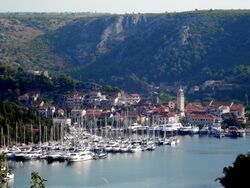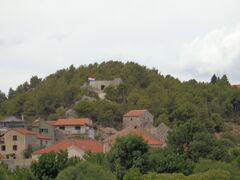سكرادين
سكرادين
Skradin | |
|---|---|
| Grad Skradin Town of Skradin | |
 منظر سكرادين | |
| الإحداثيات: 43°49′N 15°55′E / 43.817°N 15.917°E | |
| البلد | |
| المقاطعة | |
| الحكومة | |
| • العمدة | Antonijo Brajković (HDZ) |
| التعداد (2011)[1] | |
| • الإجمالي | 3٬825 |
| منطقة التوقيت | UTC+1 (CET) |
| • الصيف (التوقيت الصيفي) | UTC+2 (CEST) |
| Postal code | 22222 |
| مفتاح الهاتف | 022 |
| الموقع الإلكتروني | www |
Skradin (إيطالية: Scardona; باليونانية قديمة: Σκάρδων[2]) is a small town in the Šibenik-Knin County of Croatia, with a population of 3,825 (2011 census). It is located near the Krka river and at the entrance to the Krka National Park, 17 km (11 mi) from Šibenik and 100 km (62 mi) from Split. The main attraction of the park, Slapovi Krke, is a series of waterfalls, the biggest of which, Skradinski buk, was named after Skradin.
History
It was a Liburnian city, named Scardon (باليونانية قديمة: Σκάρδων).[2] Later it became a Roman town (Scardona in Latin), as the administrative and military centre of the region. It was destroyed during the Migration Period, and had by the 9th century been settled by Slavs.
During the 10th century, it was one of the fortified towns in Croatia, as the centre of the Skradin županija.
Skradin under Šubić rule
In the late 13th and early 14th centuries, Skradin flourished as the capital of the Šubić bans, Paul I and Mladen II. The Šubić's built the Turina fortress on the hill overlooking the Skradin harbor.[3] They elevated the settlement below the fortress to a free city, at which point it also became a commune, and was granted its own statute and administration.[4][5][6] They further enriched the city by constructing several richly-endowed monasteries which housed the Dominicans, Franciscans and other Christian orders.[7]
Decline and Ottoman conquest
Between 1522 and 1684 it was ruled by the Ottoman Empire, then again up to 1794 by the Republic of Venice.
In October 1683, the population of Venetian Dalmatia, principally Uskoks of Ravni kotari, took arms and together with the rayah (lower class) of the Ottoman frontier regions rose up, taking Skradin, Karin, Vrana, Benkovac and Obrovac.[8]
Later, it was occupied by Napoleon as part of the French Empire, then Austria-Hungary.
In time it lost its importance as the centre of the region, which shifted to Šibenik, and so it stagnated - the Diocese of Skradin was abandoned in 1828.[9]
Population
| population | 4997 | 5711 | 5865 | 6055 | 7019 | 7663 | 8454 | 8634 | 9316 | 10135 | 10294 | 9585 | 8716 | 8027 | 3986 | 3825 | 3349 |
| 1857 | 1869 | 1880 | 1890 | 1900 | 1910 | 1921 | 1931 | 1948 | 1953 | 1961 | 1971 | 1981 | 1991 | 2001 | 2011 | 2021 |
The population of the municipality is divided into the following settlements:[1]
- Bićine, population 174
- Bratiškovci, population 251
- Bribir, population 103
- Cicvare, population 18
- Dubravice, population 594
- Gorice, population 27
- Gračac, population 179
- Ićevo, population 59
- Krković, population 189
- Lađevci, population 112
- Međare, population 6
- Piramatovci, population 275
- Plastovo, population 204
- Rupe, population 470
- Skradin, population 588
- Skradinsko Polje, population 46
- Sonković, population 336
- Vaćani, population 120
- Velika Glava, population 29
- Žažvić, population 30
- Ždrapanj, population 15
Notable people
References
- ^ أ ب "Population by Age and Sex, by Settlements, 2011 Census: سكرادين". Census of Population, Households and Dwellings 2011. Zagreb: Croatian Bureau of Statistics. December 2012.
- ^ أ ب Strabo, Geography, §7.5.4
- ^ "Turina i dalje u mraku - grad spomenik gubi identitet > Slobodna Dalmacija". Archived from the original on 2019-04-16. Retrieved 2019-04-16.
- ^ Erceg, Anđela (29 September 2017). Kulturna i politička povijest grada Skradina u 19. Stoljeću (info:eu-repo/semantics/masterThesis). University of Zagreb. Department of Croatian Studies. Division of Croatology.
- ^ Klaić, Nada (24 December 1980). "How Skradin Liberated Itself from the Supremacy of the Princes of Bribir". Prilozi Povijesti Umjetnosti U Dalmaciji. 22 (1): 30–40.
- ^ Pezelj, Vilma; Erent Sunko, Zrinka; Harašić, Žaklina (2018). "Pravni položaj žene po odredbama srednjovjekovnog Skradinskog statuta". Zbornik Radova Pravnog Fakulteta U Splitu. 55 (4): 721–754. doi:10.31141/zrpfs.2018.55.130.721. S2CID 189512517.
- ^ "Skradin | Hrvatska enciklopedija".
- ^ Radovan Samardžić (1990). Seobe srpskog naroda od XIV do XX veka: zbornik radova posvećen tristagodišnjici velike seobe Srba. Zavod za udžbenike i nastavna sredstva. ISBN 9788617015631.
Становништво Млетачке Далмације, на првом месту Котарски ускоци, још у октобру 1683. дигло се на оружје заједно с ра- јом у пограничним крајевима Турске. Устаници су "сами заузели Скрадин, Карин, Врану, Бенковац и Обровац
- ^ Naklada Naprijed, The Croatian Adriatic Tourist Guide, pg. 209, Zagreb (1999), ISBN 953-178-097-8
External links
- Pages using gadget WikiMiniAtlas
- Short description is different from Wikidata
- Coordinates on Wikidata
- Articles containing إيطالية-language text
- Pages using Lang-xx templates
- Articles containing Ancient Greek (to 1453)-language text
- Official website different in Wikidata and Wikipedia
- Cities and towns in Croatia
- Populated places in Šibenik-Knin County
- Cities in ancient Illyria
- Illyrian Croatia



